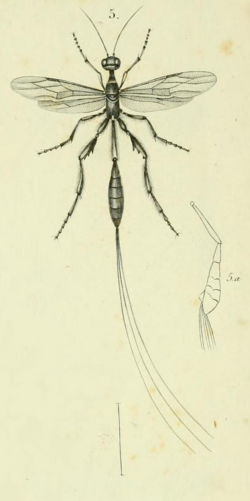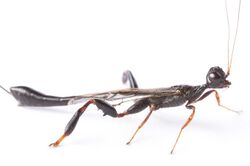Biology:Megischus
| Megischus | |
|---|---|

| |
| Jean-Gabriel Prêtre's 1846 illustration of a female M. furcatus (5) and profile view of abdomen (5a) | |

| |
| M. bicolor | |
| Scientific classification | |
| Domain: | Eukaryota |
| Kingdom: | Animalia |
| Phylum: | Arthropoda |
| Class: | Insecta |
| Order: | Hymenoptera |
| Family: | Stephanidae |
| Tribe: | Megischini |
| Genus: | Megischus Brullé, 1846 |
| Type species | |
| Megischus annulator[1] Brullé, 1846[2]
| |
| Synonyms[3][4] | |
| |
Megischus is a genus of crown-wasps in the parasitoid family Stephanidae. There are over 90 species globally distributed throughout the Neotropical, Palearctic, Afrotropical, Oriental, Australasian, and Oceanian zoogeographical regions.[5][6]
Members of the family Stephanidae are notorious for their distinct “crown” composed of 5 spike-shaped tubercles on the head.[5] The Megischus genus can be distinguished from other genera in Stephanidae by transversely depressed hind tibia and the absence of setae on the M+Cu1 vein.[7] Adult individuals of this species can reach up to 40 millimeters in length.[5] Females possess an ovipositor that exceeds their body length and is used to lay eggs in species of wood-boring beetle families including Buprestidae (Jewel Beetles), Cerambycidae (Longhorned Beetles), and Curculionidae (True Weevils). Due to their specialized parasitic lifestyle, Megischus plays a critical role in regulating the wood-boring beetle population, which can be pests for species of hardwood trees and other vegetation worldwide. In addition to beetles, some species in Megischus are parasitoids of Hymenopteran species that include species of Siricidae and solitary Apoidea.[5]
Taxonomy
- Kingdom: Animalia (Animals)
- Phylum: Arthropoda (Arthropods)
- Subphylum: Hexapoda (Hexapods)
- Class: Insecta (Insects)
- Order: Hymenoptera (Ants, Bees, Wasps and Sawflies)
- No Taxon: ("Parasitica" - Parasitoid Wasps)
- Superfamily: Stephanoidea
- Family: Stephanidae (Crown Wasps)
- Genus: Megischus
Megischus is a genus of crown wasp. It was circumscribed by Gaspard Auguste Brullé in 1846. The genus has a cosmopolitan distribution, and over ninety species are recognized.[5]
It is the type genus of the tribe Megischini, which was circumscribed by Michael S. Engel and David A. Grimaldi in 2004. [8]This tribe is in the subfamily Stephaninae in the family Stephanidae; the other genera in this tribe are Hemistephanus and Pseudomegischus. [6]
Description & Etymology
Members of the family Stephanidae are notorious for their distinct “crown” composed of 5 spike-shaped tubercles on the head.[9] The Megischus genus can be distinguished from other genera in Stephanidae by transversely depressed hind tibia and the absence of setae on the M+Cu1 vein.
Adults are typically a black or brown color and can range from approximately 10-30 mm long depending on the species (and excluding the ovipositor), with males slightly larger than females in size. [10][11]
The name “Megischus” is derived from the Greek word suffix mega meaning large and the word ischi for hip joint.[9]
Identification Characteristics
Other characteristics to identify Megischus include:
- Sub-spherical head with a crown of tubercles
- Filiform antennae, not elbowed, typically with numerous divisions (12-44)
- Metasoma petiole very long, inserted in a lower area between the hind coxae
- Wide and toothed hind femur on its ventral margin
- Long ovipositor, typically slightly longer than the body (only present in females)
- Anterior wings without a costal cell, or if present, very narrow
- At most with 3 cubital cells where the last one (c3) is open
- Tarsi without plantar lobes[12][13][14] [15]
Natural History
Life Cycle & Behavior
Specimens of Megischus are significantly more likely to be found during the summer with peak appearances occurring at the 26th week of the year. [6] Megischus are ectoparasitoids that play a critical role in regulating the wood-boring beetle population, which can be pests for species of hardwood trees and other vegetation worldwide. Adult females spend hours boring their ovipositors into wood to lay their eggs onto host larvae inside the wood. Members of the genus often target wood-boring beetle families including Buprestidae (Jewel Beetles), Cerambycidae (Longhorned Beetles), and Curculionidae (True Weevils). The female has chemosensors and a chordotonal organ to detect vibrations in order to determine a suitable host where she can lay her eggs. After developing, emerging adults chew their way out of the wood. Interestingly, males emerge several days before females. They are diurnal.[16]
Habitat
The distribution of Megischus largely mimics the distribution of hardwood trees, including oak, pine, mesquite, mangrove, and a variety of other groups that host wood-bearing Coleopteran families. [6]
Historic & Current Distribution
There are over 90 species globally distributed throughout the Neotropical, Paleartic, Afrotropical, Oriental, and Australasian and Oceanian zoogeographical regions. The majority of species of Megischus can be found in the Neotropical and Oriental regions. [10]
Conservation Status
Megischus is not considered endangered or at risk. However, more research is necessary to assess the conservation status of all species, given the global distribution and large diversity of the genus.
References
- ↑ Viereck, Henry L. (1914). "Type Species of the Genera of Ichneumon Flies". Bulletin of the United States National Museum 83: 22, 91. https://biodiversitylibrary.org/page/7818021.
- ↑ Brullé, Aug. (1846). Histoire naturelle des insectes. Hyménoptères. 4. Paris: Librairie Encyclopédique de Roret. pp. 537–540. https://biodiversitylibrary.org/page/10178115.
- ↑ Achterberg, C. van (2002). "A revision of the Old World species of Megischus Brullé, Stephanus Jurine and Pseudomegischus gen. nov., with a key to the genera of the family Stephanidae (Hymenoptera: Stephanoidea)". Zoologische Verhandelingen 339: 53–54. http://repository.naturalis.nl/record/220201.
- ↑ Chun-dan, Hong; van Achterberg, Kees; Zaifu, Xu (2010). "A new species of Megischus Brullé (Hymenoptera, Stephanidae) from China, with a key to the Chinese species". ZooKeys (69): 59–64. doi:10.3897/zookeys.69.738. PMID 21594040. Bibcode: 2010ZooK...69...59C.
- ↑ 5.0 5.1 5.2 5.3 5.4 Ge, Si-Xun; Shi, Hong-Liang; Ren, Li-Li; Tan, Jiang-Li (8 March 2021). "Description of a new species of Megischus Brullé (Hymenoptera, Stephanidae), with a key to the species from China". ZooKeys (1022): 65–77. doi:10.3897/zookeys.1022.62833. Bibcode: 2021ZooK.1022...65G.
- ↑ 6.0 6.1 6.2 6.3 Achterberg, C. van (2002). "A revision of the Old World species of Megischus Brullé, Stephanus Jurine and Pseudomegischus gen. nov., with a key to the genera of the family Stephanidae (Hymenoptera: Stephanoidea)". Zoologische Verhandelingen 339: 53–54.
- ↑ Primeras localidades de Megischus anomalipes (Foerster, 1855).pdf
- ↑ Engel, Michael S.; Grimaldi, David A. (2004). "The first Mesozoic crown wasp (Hymenoptera: Stephanidae)". Journal of Paleontology 78 (6): 1192–1197. doi:10.1017/S0022336000040440.
- ↑ 9.0 9.1 Genus Megischus BugGuide.net
- ↑ 10.0 10.1 Aguiar, A.P.; Johnson, N.F. (2003). "Stephanidae (Hymenoptera) of America North of Mexico". Proceedings of the Entomological Society of Washington 105 (2): 467–483.
- ↑ van Achterberg, C.; Quicke, D.L.J. (2006). "Taxonomic notes on Old World Stephanidae (Hymenoptera): description of Parastephanellus matsumotoi sp. n. from Japan, redescription of Commatopus xanthocephalus (Cameron) and keys to the genera Profoenatopus van Achterberg and Megischus Brullé". Tijdschrift voor Entomologie 149 (2): 215–225. doi:10.1163/22119434-900000202.
- ↑ van Achterberg, C. (2002). A revision of the Old World species of Megischus Brullé, Stephanus Jurine and Pseudomegischus gen. nov., with a key to the genera of the family Stephanidae (Hymenoptera: Stephanoidea). Zoologische Verhandelingen Leiden, 339, 1–206.
- ↑ Aguiar, Alexandre P. (3 December 2004). "World catalog of the Stephanidae (Hymenoptera: Stephanoidea)". Zootaxa 753 (1): 1. doi:10.11646/zootaxa.753.1.1.
- ↑ 16195760[1]
- ↑ Primeras localidades de Megischus anomalipes (Foerster, 1855).pdf
- ↑ Taylor, KL (1967). "Parasitism of Sirex noctilio F. by Schlettererius cinctipes (Cresson) (Hymenoptera: Stephanidae)". Journal of the Australian Entomological Society 6: 13–19. doi:10.1111/j.1440-6055.1967.tb02132.x.
Wikidata ☰ Q18595266 entry
 |


